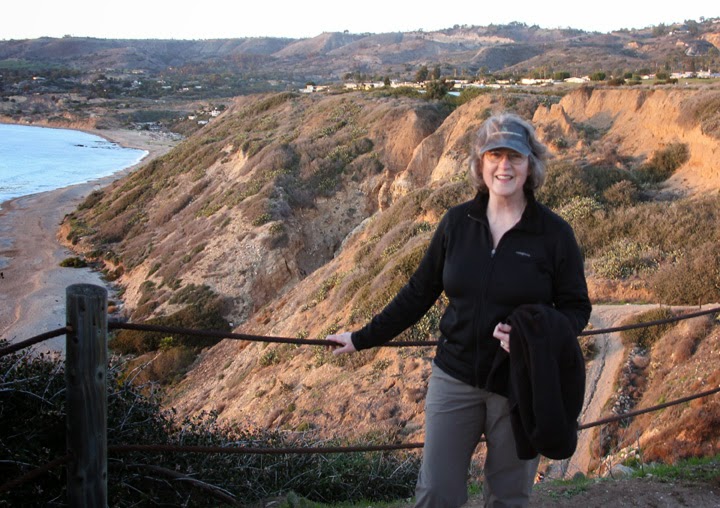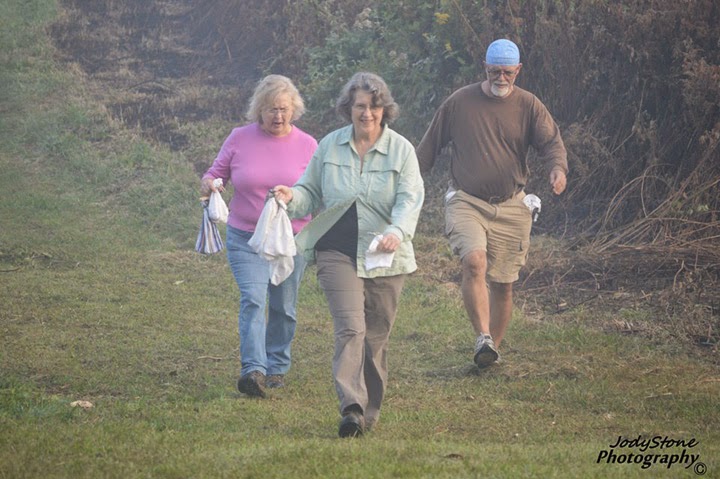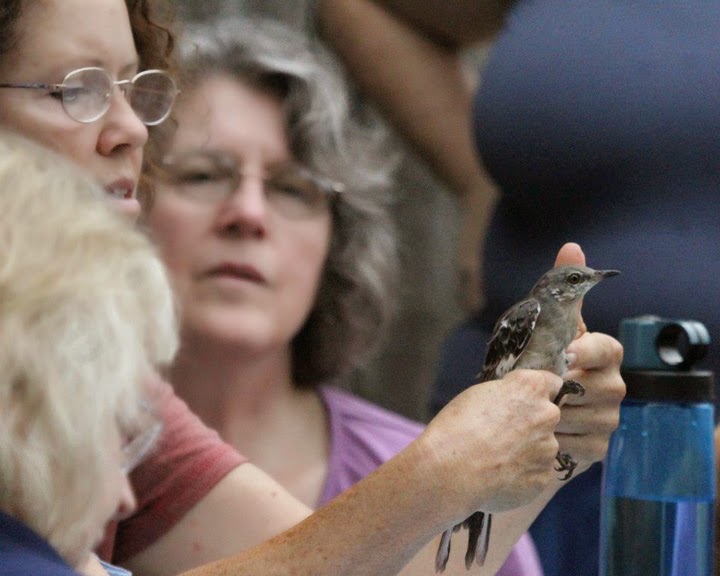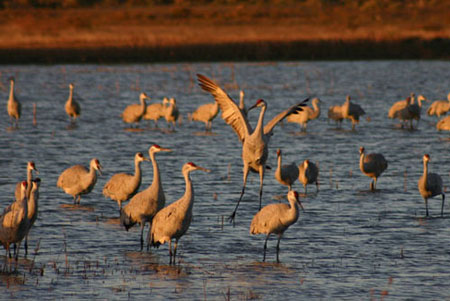A snow white beauty with pink bill, pink skin and red eyes, this albino ruby-throated hummingbird is visiting the home of friends, Cyndi and Steve Routledge, in middle Tennessee. (I'm ready to jump in the car and drive the four hours to visit them!)
One can't be entirely certain of the species because rufous hummingbirds from the west have already appeared in Tennessee, but since albino pigmented hummingbirds are short lived, this is more than likely a juvenile ruby-throated hummingbird.
According to Mark Armstrong, our Master Bander of hummingbirds here in Knoxville, Tennessee, Bob Sargent has banded about 50 albino hummingbirds over his career as a bander, but none have ever returned in subsequent years.
Albinism is a genetic mutation that prevents the production of melanin in the body, which is required for pigmentation or color. Albinistic birds have pink or red eyes because of this lack of pigmentation--the eyes are reflecting the red color of the blood vessels. Albinistic birds seldom live long because they are more visible to predators. Their odd appearance makes it more difficult for them to attract a mate so the genetic mutation for albinism is seldom passed to the next generation, making the occurrence of albinism very rare.
Cyndi describes their surprise discovery of the bird. "Steve first spotted the white bird on late Thursday afternoon (9/19). It was high in the canopy in our side yard in the afternoon sun searching for insects. At first he thought it was a big white moth, but soon realized what it truly was. He called to me (I was making dinner) and I was able to get a quick glimpse of it as it flew up and over the tree into the neighbor's yard."
Steve and Cyndi set up watch at the front and back feeders of their house and soon their snow white visitor reappeared.
Above, albino ruby-throated hummingbird scratching. All photo credits in this post: Cyndi Routledge
The albino bird has been at the Routledges for four days. Cyndi says, "He/she likes to perch in our Snowball Hydrangea bush. Because it's white we have no way of knowing male or female unless it's "in hand". I sent the pictures to Bob Sargent Thursday night since we were not sure whether it was a true albino or leucistic. Bob believes it's a true albino because it has pink legs, a pink bill, a red eye and pink skin."
Cyndi describes the bird as very vocal, "chattering away" when another ruby-throat comes into view. "He likes to sit in the sunshine and preen, and I had a wonderful time watching him as it began to rain on Friday afternoon. It was like he was taking a shower--fluffing and shaking and getting a quick drink from the raindrops on the leaves of the hydrangea."
"Alby, as Steve calls it, is very territorial of the hummingbird feeder that hangs right at the base of the hydrangea bush. He chases off all other ruby-throats and this morning was chasing off Tufted Titmice who at first were actually chasing him/her. My best guess was they, like ourselves, thought it was a large moth!"
"He also very much likes the salvia guaranitica (a gift from Bob and Martha Sargent this past spring) that is planted along our front sidewalk." (pictured above)
"This tiny little white bird is truly an amazing sight…it's a tiny little white angel."
Cyndi Routledge
All photo credits in this blog post: Cyndi Routledge, photographer and naturalist in Clarksville, TN.
Ruby-throated Hummingbirds
Hummingbird Study Group
Cornell on Albinism and Leucism
Banding hummingbirds
Hummingbird migration
Sunday, September 22, 2013
Friday, September 20, 2013
Seven Islands Becomes Tennessee's First State Birding Park
Visits to Seven Islands Wildlife Refuge over the past several years rapidly turned this wildlife sanctuary into one of my all-time favorite Tennessee natural areas.
Encompassing more than 410 acres along the French Broad River, this open grassland habitat is planted with native grasses, wildflowers, shrubby fruit-bearing plants, and trees that provide the favored habitat and food sources for many declining grassland bird species. It was here that I became acquainted with several new species of warblers and sparrows, learned about bird banding and participated with the Knoxville Chapter of the Tennessee Ornithological Society (KTOS) bird banding team in gathering information about the birds that breed and winter on the refuge.
Today I had the pleasure of attending the Legacy Luncheon for the Parks which took place beside the French Broad River at Seven Islands Wildlife Refuge. Speaking to a record crowd of over 700 people who were present to support the work of the Legacy Parks Foundation, special guest, Governor Bill Haslam, announced that Seven Islands Wildlife Refuge is becoming Tennessee's 56th state park and the first in an anticipated series of State Birding Parks to be established across Tennessee.
Legacy Parks Foundation Board Chair, Chad Youngblood (below left), honors Pete and Linda Claussen for their generous and dedicated efforts in developing the refuge and fostering its transformation into Seven Islands State Birding Park.
Among others, Wayne Schacher (below left), former refuge land manager and KTOS member, was recognized for his years of work on the refuge restoring native warm-season grasses, enhancing riparian and wetland areas, and developing habitat diversification for the benefit of wildlife species on the refuge. In addition to the recreation value of nature trails and a river ramp for launching kayaks and canoes, the refuge has historically offered educational and research opportunities. KTOS has conducted bird banding studies on the refuge for many years.
It was a special honor to be asked to create a watercolor to commemorate this event for the Legacy Parks Foundation. The subject of that watercolor is a beautiful warbler that we often see and hear on the refuge--a Common Yellowthroat.
Below you see one of the signed and numbered limited edition prints that decorated the tables at the luncheon.
The Legacy Parks Foundation works to assure that our community enjoys exceptional recreational opportunities, natural beauty and open spaces by securing funding for land acquisitions and park improvements, accepting gifts of land, providing maintenance for greenway and conservation easements, and advocating for parks and outdoor recreation.
Seven Islands Wildlife Refuge
Seven Islands - Outdoor Knoxville with map
Legacy Parks Foundation
Seven Islands articles published in The Tennessee Conservationist Magazine
Bird banding at Seven Islands Wildlife Refuge
Knoxville Chapter, Tennessee Ornithological Society
Tennessee State Parks
WATE news coverage with video
Report from Chattanoogan
WBIR video coverage
Friday, September 13, 2013
A Peek into the Life of a Chimney Swift
Mark Armstrong, master bander of both songbirds and hummingbirds, and his wife Janie Kading, have a chimney swift tower that Mark constructed in their back yard
For several years swifts have nested in the tower. Small holes are drilled in the bottom of the base so that you can look up and actually see how many nestlings have their heads over the nest edge and how many swifts are roosting on the chimney wall.
This breeding season a pair of chimney swifts raised at least three young in the tower. The nests are shallow and when considering its small size, it is hard to imagine how three nestlings can fit into it. Both the male and female bring sticks to build the nest, breaking them off with their feet and carrying them to the nest site in their beak. The twigs are then sealed with sticky saliva from the swift's seasonally enlarged sublingual glands
Even more fascinating is the description found in the account of Birds of North America notating the timing of egg-laying. "Egg-laying begins when nest half-finished at about 3-6 d, and new twigs and saliva added during incubation...." The pair stops adding sticks shortly before the eggs hatch.
On July 1st, Mark and Jane set up traps to capture and band hummingbirds in their yard. In addition, to the hummingbird traps, a mist net was set up to capture hummingbirds and possibly a swift as it left the tower after feeding young.
Above, you see the band being attached to a swift's leg. A swift's feet and legs are weak, similar in structure to those of the hummingbird, and are used for gripping and grasping but not for perching. The chimney swift is airborne most of its life and uses its sharp claws to cling to vertical surfaces while roosting. Also, notice how long the wings are in relation to the body. The swift's interesting tail structure also is clearly an additional support while roosting. The feathers end in sharp barbs that help to support the bird while clinging to the roosting surface.
The swift's interesting tail structure also is clearly an additional support while roosting. The feathers end in sharp barbs that help to support the bird while clinging to the roosting surface. After the young fledged, other swifts in the area joined the family in the tower at roosting time and as many as 15 were counted before all the swifts departed on migration. Presently, swifts are migrating through our area and known communal roosts are being monitored to count the number of swifts as they enter the chimney. The highest count from one chimney that I've seen reported to date was 10,000 in the Nashville area (reported last week).
Links and Resources:
Chimney Swifts coming to roost during migration
Chimney Swifts
Mark Armstrong also banding hummingbirds
Swift Night Out
Chimney Swift Tower
Knoxville Chapter, Tennessee Ornithological Society
Tennessee Ornithological Society
Chimney Swifts coming to roost during migration
Chimney Swifts
Mark Armstrong also banding hummingbirds
Swift Night Out
Chimney Swift Tower
Knoxville Chapter, Tennessee Ornithological Society
Tennessee Ornithological Society
Saturday, September 7, 2013
Swift Night Out--Lenoir City, Tennessee
Swift Night Out is a fun and amazing way to spend an evening. Not only are participants helping to count chimney swifts during migration but they personally experience one of nature's avian wonders--the high-speed roosting ritual of chimney swifts.
The show begins at dusk and lasts about 30 minutes. When we first arrived at the site, the historic War Memorial Building in Lenoir City, Tennessee, it was about 8:10 pm. We saw and heard one swift overhead but in less than five minutes, hundreds appeared flying overhead, some coming down near the tops of our heads and curving past us. Suddenly, they seemed to be everywhere. Swifts initially swirled around the chimney in fly-bys, until eventually, one by one, they began dropping into the chimney. And that's what it looks like, as though they've turned off the "engine", and with heads pointed downward, allow gravity to propell them into the chimney.
The mass momentum builds until dozens of birds may descend in rapid succession. At one point, the sky suddenly became silent. No sound. No birds. Denise described it as happening routinely, "as though someone turned off a faucet" and I agreed. Another burst of activity followed beginning a few minutes after the pause, and lasting only a few minutes more until the flock was settled in for the night.
My videos will introduce you to the phenomenon but it is definitely one of those events that you will want to experience in person. In the video background you can hear a generator but the chirping of the swifts overhead can still be clearly heard. Just how swifts synchronize this roosting frenzy so that everyone lands safely inside is beyond comprehension. One wonders how they know about the chimney and judge its walls to be safe. How can over 500 swifts find roosting space in a chimney that does not appear all that large? How do the birds manage to grab a perch while in the midst of communal high-speed descent? Are these birds local birds gathering prior to migration or migrants passing through or both?
Denise and Tony King, of Lenoir City, members of the Knoxville Chapter of the Tennessee Ornithological Society, have been watching and counting chimney swifts in Lenoir City for about six years. They first became interested when they noticed the large numbers of swifts coming to roost in a chimney in their neighborhood. That roost site is no longer there but it spawned their interest and a search around town revealed other migration roosting sites. The historic War Memorial Building chimney is the largest and most active they've found in the area.
Above, a chimney swift held in a banders grip.
Denise and Tony participate in a Swift Night Out, an effort to increase interest in swifts and to locate and count migrating Chimney Swifts and Vaux Swifts. Chimney swifts are believed to be declining due to the destruction of old chimneys commonly used for roosting sites and required for nesting. Old chimneys found at industrial sites, churches and older homes are likely places for a communal roost.
To find a known swift roosting site near you visit the website's list of 2012 roost sites all across the country and click this link to see reports thus far in 2013 . A phone call to your local birding organization may also help you get acquainted with members who can introduce you to a roost site.
Next: A look at Chimney Swifts from the banding table
Links and Resources:
Chimney Swifts at Cornell All About Birds
Swift Night Out
Chimney Swifts.org
War Memorial Bldg--Lenoir City
Knoxville Chapter, Tennessee Ornithological Society
The show begins at dusk and lasts about 30 minutes. When we first arrived at the site, the historic War Memorial Building in Lenoir City, Tennessee, it was about 8:10 pm. We saw and heard one swift overhead but in less than five minutes, hundreds appeared flying overhead, some coming down near the tops of our heads and curving past us. Suddenly, they seemed to be everywhere. Swifts initially swirled around the chimney in fly-bys, until eventually, one by one, they began dropping into the chimney. And that's what it looks like, as though they've turned off the "engine", and with heads pointed downward, allow gravity to propell them into the chimney.
The mass momentum builds until dozens of birds may descend in rapid succession. At one point, the sky suddenly became silent. No sound. No birds. Denise described it as happening routinely, "as though someone turned off a faucet" and I agreed. Another burst of activity followed beginning a few minutes after the pause, and lasting only a few minutes more until the flock was settled in for the night.
My videos will introduce you to the phenomenon but it is definitely one of those events that you will want to experience in person. In the video background you can hear a generator but the chirping of the swifts overhead can still be clearly heard. Just how swifts synchronize this roosting frenzy so that everyone lands safely inside is beyond comprehension. One wonders how they know about the chimney and judge its walls to be safe. How can over 500 swifts find roosting space in a chimney that does not appear all that large? How do the birds manage to grab a perch while in the midst of communal high-speed descent? Are these birds local birds gathering prior to migration or migrants passing through or both?
Denise and Tony King, of Lenoir City, members of the Knoxville Chapter of the Tennessee Ornithological Society, have been watching and counting chimney swifts in Lenoir City for about six years. They first became interested when they noticed the large numbers of swifts coming to roost in a chimney in their neighborhood. That roost site is no longer there but it spawned their interest and a search around town revealed other migration roosting sites. The historic War Memorial Building chimney is the largest and most active they've found in the area.
Above, a chimney swift held in a banders grip.
Denise and Tony participate in a Swift Night Out, an effort to increase interest in swifts and to locate and count migrating Chimney Swifts and Vaux Swifts. Chimney swifts are believed to be declining due to the destruction of old chimneys commonly used for roosting sites and required for nesting. Old chimneys found at industrial sites, churches and older homes are likely places for a communal roost.
To find a known swift roosting site near you visit the website's list of 2012 roost sites all across the country and click this link to see reports thus far in 2013 . A phone call to your local birding organization may also help you get acquainted with members who can introduce you to a roost site.
Next: A look at Chimney Swifts from the banding table
Links and Resources:
Chimney Swifts at Cornell All About Birds
Swift Night Out
Chimney Swifts.org
War Memorial Bldg--Lenoir City
Knoxville Chapter, Tennessee Ornithological Society
Sunday, September 1, 2013
A Hummer Encounters a Praying Mantis
This male ruby-throated hummingbird's behavior alerted me that something was happening beyond the usual hummingbirds advancing on his feeders. He was turning his head from side to side far more frequently than typical for a hummer guard behavior.
The color of the praying mantis blended so completely into the hues of the holly, that even when I knew where he was, the insect was hard to find. In the image below, he is located on the limb below the hummer's perch, hanging upside down, about in line with the hummer's beak.
Not yet bothered enough to give up his perferred limb, the hummer continued protecting his nectar source. Below, you see him perched on the holly twig with the praying mantis lurking underneath the limb below him.
The hummer dropped down to check him out several times. Each time, I held my breath!
Back to the perch again.
A closer look at the praying mantis as he hangs from the holly limb. Notice the sharp appendages on his legs.
The hummer returned to his twig perch briefly, but this time seemed disturbed by the mantis' new position. After several brief touch-downs followed by hovering, to my relief, he moved to a new perch!
Another reason to be totally amazed by the life and behavior of ruby-throated hummingbirds!
Links and resources:
For a quick look at how a preying mantis strikes its prey: Perfect Predator
Hummingbirds and pollination
Hummingbird Banding
More posts on Ruby-throated Hummingbirds on this blog
Hummingbird art at Vickie's Sketchbook
I continued to watch until he revealed the subject of his divided attention. In the image below, you can see a praying mantis on the dark leaf in the holly, just above and behind the hummer's head. Praying mantis prey on hummingbirds. I briefly considered moving it out of the holly, but decided I shouldn't interfere and, instead, watched to see what would happen. Needless to say, these weren't the most relaxing observations of hummer behavior I've experienced!
The male-ruby throat ignored the praying mantis most of the time, but ever so often, the insect would get his attention--possibly with a movement--and the hummer would investigate. This was a little un-nerving. I've never seen a praying mantis strike its prey and I wasn't interested in seeing that happen. On the other hand, I was glad to see that the hummer was aware and keeping track of the insect's behavior.
Below, the hummer leaves his perch and hovers near the mantis to get a closer look.
Soon after this interaction. while the hummer was away from his perch, the mantis traveled down the leaves to a limb below the hummers perching twig.
The color of the praying mantis blended so completely into the hues of the holly, that even when I knew where he was, the insect was hard to find. In the image below, he is located on the limb below the hummer's perch, hanging upside down, about in line with the hummer's beak.
The hummer continued to guard his feeders, but to my relief, he appeared very aware of the praying mantis. He discovered the mantis in his new location and investigated.
Not yet bothered enough to give up his perferred limb, the hummer continued protecting his nectar source. Below, you see him perched on the holly twig with the praying mantis lurking underneath the limb below him.
The hummer dropped down to check him out several times. Each time, I held my breath!
Back to the perch again.
A closer look at the praying mantis as he hangs from the holly limb. Notice the sharp appendages on his legs.
Below, you see the hummer on his twig, and the mantis still below, but the insect has moved again. This time, he has crawled up even with the limb, holding on to leaves with his hind legs while keeping his front legs free. Each time the hummer lands on the twig it bends closer to the praying mantis, especially when perched on the lower end.
A closer view of the mantis' new position in the image below. It became clear to me at this point, if I had had any doubt before, that the mantis was stalking the hummingbird. With each new position, the insect moved closer to the hummingbird. I don't mind saying, watching this progression gave me the creeps!
The hummer returned to his twig perch briefly, but this time seemed disturbed by the mantis' new position. After several brief touch-downs followed by hovering, to my relief, he moved to a new perch!
Another reason to be totally amazed by the life and behavior of ruby-throated hummingbirds!
Links and resources:
For a quick look at how a preying mantis strikes its prey: Perfect Predator
Hummingbirds and pollination
Hummingbird Banding
More posts on Ruby-throated Hummingbirds on this blog
Hummingbird art at Vickie's Sketchbook
Subscribe to:
Posts (Atom)
Ocean Trail at Palos Verdes Nature Preserve, California--2015

Bird-banding at Seven Islands State Birding Park--2014

Photo courtesy of Jody Stone
Bird-banding at Seven Islands

Photo courtesy of Karen Wilkenson
Enjoying Gray Jays in Churchill!--2014

Photo courtesy of Blue Sky Expeditions
Smithsonian National Zoo with one of my Whooping Crane banners and son, John--2014

The Incredible Muir Woods near Stinson Beach, CA--2014

Photo courtesy of Wendy Pitts Reeves
Me and Denali--2012

Photo courtesy of Bob King
For the Love of It...
...the sage sees heaven reflected in Nature as in a mirror, and he pursues this Art, not for the sake of gold or silver, but for the love of the knowledge which it reveals.
Sendivogius (1750)
Sendivogius (1750)
Your Uncapped Creativity...

"There is a vitality, a life force, an energy, a quickening that is translated through you into action; and because there is only one of you in all time, this expression is unique. If you block it, it will never exist through any other medium and it will be lost. The world will not have it. You must keep that channel open. It is not for you to determine how good it is, nor how valuable. Nor how it compares with other expressions. It is for you to keep it yours, clearly and directly." ----the great dancer, Martha Graham











































